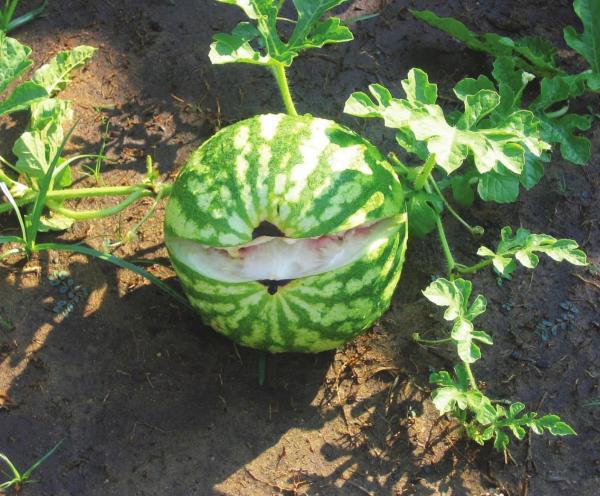The winter garden
If, like me, you can’t wait for that first bite of a summer watermelon. Many of us got our watermelon plants in the ground in April or May but you can still plant them up until about mid-June. The growing conditions needed include lots of sunshine during the day and warm nights. That sure sounds like central Texas Weather. Watermelon is great sliced, in fruit salads, grilled, and the rind is even used hollowed out as a serving basket or bowl – or like my great grandmother you can make watermelon rind pickles! Understanding the best growing conditions for watermelons will help you grow this wonderful fruit.
Watermelons will require lots of space, as the plants are vines and will spread. I start my melons off as transplants and plant them far out in my yard, all by themselves, on small mounds spaced 2 to 3 feet apart. Keep the area free from weeds. A good, shallow hoeing is best. You do not want to disturb the roots, and you certainly don’t want to cut any shoots off the main plant.
So how long does watermelon take to grow? Growing watermelons takes about 120 days from start to finish. How do you know they are ripe and ready to harvest? You’ll notice that those little curly tendrils that start forming will turn brown and get a little crisp. Also, the color of the melon will get duller. The skin of the watermelon will be hard and resistant to the penetration of your fingernail when you try to press it into the melon. Another way to know if the melon is ripe is to pick one up and turn it over. If the bottom where it sits in the soil is yellow and not white, the watermelon is probably ripe.
Watermelons are a summer favorite but sometimes gardeners find that these juicy melons can be a little tricky to grow. Knowing how and when to water can leave a home gardener feeling a little perplexed. They need plenty of water, but it is actually pretty simple, watermelons need watering throughout the season, but a particularly important time is while they are setting and growing fruit. The reason for this is that watermelon is up 92% water. This means that the plant must take up an enormous amount of water while the fruit is developing. If this water is not available to the plant the fruit will not be grow to its full potential and may be stunted or it might fall off the vine.
It is also important to water while they are establishing in the garden or during times of super heat or drought. Again, that sounds like central Texas weather to me!
Watering isn’t complicated but should be done correctly. First, make sure that you are watering at ground level, rather than from above. Using drip irrigation rather than a sprinkler system will help prevent powdery mildew from developing on the leaves and will also stop dirt from splashing about, potentially spreading harmful disease.
The second thing to be aware of is that you need to water deeply. Watermelon roots go deep searching for water to support the water hungry fruit. Water the plants so that the water goes down at least 6 inches into the soil. This may take at least a half hour, perhaps even more depending on the drip rate of your watering system.
Watering does not need to be a scary or complicated process. Just take your time and provide water regularly and down low and you will have lovely and juicy watermelons in no time.
One of the most frequently ask questions is “what makes watermelons split in my garden?”
There are a few common causes of watermelon splits. The most common cause for a bursting watermelon is erratic watering. Whether it’s due to poor irrigation practices or drought followed by heavy rain, excessive accumulation of water can put the fruit under a lot of pressure. As with tomato cracking, when the plants absorb too much water too fast, the excess water goes straight to the fruits. When the soil becomes dry, the fruit forms a tight skin in order to prevent moisture loss. However, once a sudden surge in water returns, the skin tries to expand and simply cannot, as a result, the watermelon bursts.
Another possibility, in addition to water, is heat. Water pressure within the fruit can build up when it gets too hot, causing the melons to split open. One way to help alleviate splitting is by adding straw mulch, which will help retain moisture in the soil and insulate plants. Adding shade covers during excessively hot periods may help too. I plant mine so that large pecan trees offer late afternoon shade for my watermelons.
Finally, this may be attributed to certain cultivars as well. Some varieties of watermelon may simply be more prone to splitting than others. In fact, many thin-rind types, such as Icebox, have even been nicknamed “exploding melon” for this reason.
As previously mentioned, watermelons require significant space. Not only do the vines reach considerable length, but the fruit itself can weigh as much as 200 pounds! While most of us will get nowhere near that blue-ribbon size, there can still be the problem of those long ranging vines. So, to curtail the size, it is indeed possible to prune the plant.
Pruning watermelons promotes healthier vines and increases fruit size. Look for irregular or rotting fruit to prune from the plant. Removing the less than perfect melons will enable the plant to focus energy towards growing bigger, healthier, juicier melons.
The downside to watermelon trimming is that it may affect pollination. Watermelons need both male and female flowers to set fruit. Cutting watermelon vines back may reduce the number of female flowers, of which there are fewer than male, about one female for every seven male blooms. Obviously, with no female blooms for the bees to cross pollinate to the male blooms, there will be no fruit.
Also, cutting back watermelon plants can cause the plant to send out additional runners. This can delay fruit set because the plant is focusing its energy on growing vines instead of developing melons.
Lastly, a watermelon plant’s rapid growth and spread tends to retard weeds by blocking the sunlight, thereby preventing weeds from getting the nutrition they need to sprout. If you cut too much of the watermelon back, you will likely be unwittingly encouraging weed growth. Not a big deal if you don’t mind pulling weeds. You can also use a good layer of dark mulch around the plants to control weed growth.
Grow watermelon in your garden just once and, like me, you’ll be hooked for life!



